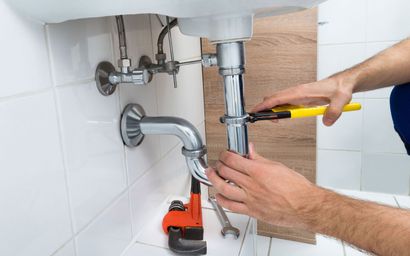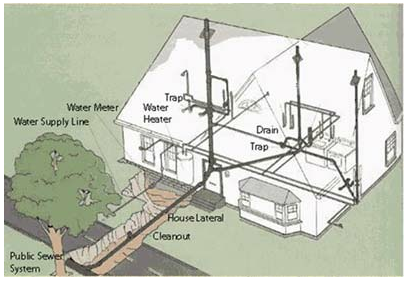The Layout of Your House's Plumbing System Explained
The Layout of Your House's Plumbing System Explained
Blog Article
The publisher is making a number of great observations regarding Understanding Your Home's Plumbing Anatomy as a whole in this article following next.

Comprehending just how your home's pipes system works is vital for every single homeowner. From delivering clean water for alcohol consumption, food preparation, and bathing to safely eliminating wastewater, a properly maintained pipes system is crucial for your household's wellness and convenience. In this comprehensive guide, we'll explore the elaborate network that comprises your home's pipes and deal ideas on upkeep, upgrades, and dealing with usual issues.
Intro
Your home's plumbing system is greater than just a network of pipes; it's a complex system that ensures you have access to clean water and efficient wastewater elimination. Knowing its components and exactly how they collaborate can aid you protect against costly repairs and make sure whatever runs smoothly.
Fundamental Components of a Plumbing System
Pipes and Tubing
At the heart of your plumbing system are the pipes and tubing that carry water throughout your home. These can be constructed from numerous materials such as copper, PVC, or PEX, each with its advantages in terms of toughness and cost-effectiveness.
Components: Sinks, Toilets, Showers, and so on.
Components like sinks, commodes, showers, and bath tubs are where water is made use of in your house. Recognizing just how these components attach to the pipes system aids in identifying issues and preparing upgrades.
Valves and Shut-off Points
Valves control the flow of water in your pipes system. Shut-off shutoffs are vital throughout emergencies or when you need to make repair work, allowing you to isolate parts of the system without interfering with water circulation to the whole home.
Supply Of Water System
Main Water Line
The main water line attaches your home to the metropolitan water system or a personal well. It's where water enters your home and is distributed to various components.
Water Meter and Stress Regulatory Authority
The water meter procedures your water usage, while a pressure regulatory authority makes sure that water flows at a safe stress throughout your home's pipes system, stopping damage to pipes and components.
Cold Water vs. Warm water Lines
Comprehending the distinction between cold water lines, which provide water straight from the major, and hot water lines, which carry heated water from the water heater, assists in fixing and planning for upgrades.
Drainage System
Drain Pipes Pipeline and Traps
Drain pipelines bring wastewater away from sinks, showers, and commodes to the drain or septic tank. Catches avoid sewage system gases from entering your home and likewise trap particles that might create blockages.
Air flow Pipes
Air flow pipes enable air right into the drain system, stopping suction that could slow water drainage and create traps to vacant. Proper ventilation is necessary for maintaining the integrity of your pipes system.
Importance of Correct Drainage
Making sure proper drain prevents back-ups and water damage. Consistently cleaning up drains pipes and preserving catches can avoid costly repair services and extend the life of your plumbing system.
Water Heating System
Sorts Of Water Heaters
Hot water heater can be tankless or conventional tank-style. Tankless heaters warm water on demand, while containers store heated water for instant use.
Updating Your Plumbing System
Factors for Upgrading
Updating to water-efficient components or changing old pipelines can enhance water top quality, reduce water expenses, and boost the worth of your home.
Modern Pipes Technologies and Their Benefits
Explore innovations like smart leak detectors, water-saving bathrooms, and energy-efficient water heaters that can conserve cash and lower environmental effect.
Price Factors To Consider and ROI
Compute the upfront costs versus long-term financial savings when taking into consideration plumbing upgrades. Many upgrades pay for themselves through decreased utility expenses and fewer repair work.
Exactly How Water Heaters Attach to the Pipes System
Recognizing just how hot water heater link to both the cold water supply and warm water circulation lines aids in detecting problems like inadequate hot water or leaks.
Maintenance Tips for Water Heaters
On a regular basis flushing your water heater to remove sediment, examining the temperature level setups, and checking for leakages can prolong its life expectancy and improve energy performance.
Usual Pipes Problems
Leaks and Their Causes
Leaks can happen because of maturing pipelines, loosened fittings, or high water stress. Addressing leakages promptly protects against water damage and mold and mildew development.
Blockages and Obstructions
Blockages in drains and bathrooms are often triggered by purging non-flushable items or a build-up of oil and hair. Making use of drain screens and bearing in mind what goes down your drains pipes can protect against blockages.
Signs of Pipes Issues to Watch For
Low tide pressure, slow drains pipes, foul odors, or uncommonly high water bills are signs of possible plumbing problems that need to be resolved immediately.
Plumbing Maintenance Tips
Normal Evaluations and Checks
Schedule yearly pipes assessments to catch concerns early. Seek indications of leakages, rust, or mineral buildup in taps and showerheads.
DIY Upkeep Tasks
Easy tasks like cleansing tap aerators, looking for toilet leakages utilizing color tablets, or insulating subjected pipes in cool climates can protect against major pipes concerns.
When to Call a Professional Plumber
Know when a pipes issue needs professional expertise. Trying complicated repairs without appropriate knowledge can bring about more damages and higher fixing prices.
Tips for Minimizing Water Use
Simple practices like dealing with leakages immediately, taking much shorter showers, and running full loads of washing and dishes can save water and reduced your utility bills.
Eco-Friendly Plumbing Options
Take into consideration sustainable plumbing products like bamboo for flooring, which is durable and eco-friendly, or recycled glass for counter tops.
Emergency Readiness
Steps to Take During a Pipes Emergency
Know where your shut-off valves are located and just how to switch off the supply of water in case of a ruptured pipe or significant leakage.
Value of Having Emergency Situation Contacts Useful
Maintain contact info for regional plumbing technicians or emergency services readily available for fast action throughout a plumbing dilemma.
Ecological Impact and Conservation
Water-Saving Fixtures and Appliances
Setting up low-flow faucets, showerheads, and toilets can significantly decrease water usage without sacrificing performance.
DIY Emergency Fixes (When Appropriate).
Momentary solutions like making use of air duct tape to spot a dripping pipe or putting a container under a dripping tap can lessen damage up until a professional plumbing shows up.
Conclusion.
Understanding the composition of your home's plumbing system encourages you to keep it properly, conserving time and money on repair work. By following routine maintenance regimens and remaining notified regarding modern-day pipes innovations, you can guarantee your pipes system operates efficiently for years ahead.
HOW YOUR PLUMBING SYSTEM WORKS
Which Pipes Do What?
Blue lines = fresh water supply entering the building Red lines = hot water supply entering the building Grey lines = pipes carrying waste away from the building and venting pipes carrying gases away from the building (through the roof) YOUR MAIN PLUMBING SYSTEMS
There are two main plumbing systems that support your home s basic plumbing needs one that brings clean water into your home, and one that sends dirty water away from your home. Connected to the toilet, bath, shower, and other faucets in your home, these two systems keep your water flowing in the right directions.
ACCESSING FRESH WATER
Fresh and clean water is brought into your home through the main water supply line . Filtered through one pipe, this water is pressured to flow into the various fixtures in your home at any given time.
This water can be sourced from a well located on your property, a pond or river (mostly cottages), or, as in most cases, from the city s municipal water treatment centre. However, it is important to note that water that is untreated, such as the water siphoned from ponds or rivers, may not be safe to drink. Personal water supplies always need to be treated for hardness and contaminants before consumed.
MUNICIPAL WATER SUPPLIES
Improve taste and odour Remove sediment Eliminate hardness Reduce chlorine COLD WATER SUPPLY VS. HOT WATER SUPPLY
Cold water flows into your home or building through the service line, which then distributes hot or cold water to your fixtures. This line is most commonly run through a central column that runs floor to floor. Hot water runs in short and straight pipes as the longer the pipeline, the more heat that will be lost in the transfer. Having shorter pipes also allows residents to access hot water more quickly.
WASTE WATER SYSTEM
Your wastewater system is divided into two parts pipes that send wastewater away from your home and venting pipes that send sewer gas away from your home. Sewage water travels through pipes that flush the water and waste towards local sewers that are operated and managed by your city or town. Most sewer systems rely on gravity to move the wastewater to where it needs to go.
The further away from your toilet or sink, the larger wastewater pipes become. This allows for waste to be disposed of from various parts of your home or business at once without pipe blockages. The angle and flow of these pipes are also essential for keeping your waste pipes clear of build up.
https://harrisplumbing.ca/how-your-home-plumbing-system-works/

Do you like more info about Understanding Your Home's Plumbing Anatomy? Write a remark down below. We would be pleased to hear your ideas about this entry. We hope that you visit us again in the near future. Do you know about someone else who is interested in the subject? Why not share it. Thank you for being here. Return soon.
Book Today Report this page